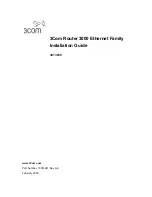
Appendix C. NL241 Settings
C-15
uniquely identified by the IP address and a port number. This entry is where
the port number of the NL241 TLS server is set.
The TLS client needs to be set to communicate on this port number. If secure
communications come in on the
TLS Proxy Service Port
, the NL241 will
attempt to open a TCP connection to the datalogger on the
TLS Proxy
Forward Port
. Also, regardless of this setting, the NL241 Secure Proxy Server
will always listen on the secure HTTP (HTTPS) port number 443. If a secure
connection is established on this port, the NL241 will attempt to communicate
to the datalogger on the HTTP port 80 (range 1 to 65535).
TLS Proxy Forward Physical Port
When doing TLS Proxy communications, the NL241 TLS server maintains a
secure connection with a remote client. If the
TLS Proxy Forward Physical
Port
is specified to be the
CS I/O Port
, the NL241 will open a TCP
connection with the datalogger over the CS I/O port and do unencrypted data
transfer with the datalogger. If the
TLS Proxy Forward Physical Port
is
specified to be
Wi-Fi
, the NL241 will open the TCP connection over Wi-Fi on
the
TLS Proxy Forward IP Address
.
TLS Proxy Forward IP Address
Secure communications received on the NL241 TLS server will be forwarded
on a non-secure TCP connection to this IP address. If the
TLS Proxy Forward
Physical Port
is specified to be the
CS I/O Port
, this setting does not need to
be set by the user since the NL241 will obtain the IP address of the datalogger
automatically. The datalogger must be configured with a static IP address that is
unique and that exists on the same subnet as the NL241's IP address. If the
TLS
Proxy Forward Physical Port
is specified to be
Wi-Fi
, the forward IP address
must be specified. Enter the IP address of the destination datalogger here.
TLS Proxy Forward Port
When doing TLS Proxy communications, the NL241 TLS server maintains a
secure connection with a remote client. If the
TLS Proxy Forward Physical
Port
is specified to be the
CS I/O Port
, the NL241 will open a TCP
connection with the datalogger over the CS I/O port and do unencrypted data
transfer with the datalogger. If the
TLS Proxy Forward Physical Port
is
specified to be
Wi-Fi
, the NL241 will open the TCP connection over Wi-Fi on
the
TLS Proxy Forward IP Address
.
In order to communicate with the connected datalogger’s TCP server, the
NL241’s TCP client application must open a socket to that server. The socket
of the datalogger’s TCP server is uniquely identified by an IP address and a
port number. This entry is where the port number of the NL241’s TCP client is
set. The datalogger TCP service port must be set to communicate on this port
number.
If secure communications come in on the
TLS Proxy Service Port
, the NL241
will attempt to open a TCP connection to the datalogger on the
TLS Proxy
Forward Port
. Also, regardless of this setting, the NL241 TLS Proxy Server
will always listen on the secure HTTP (HTTPS) port number 443. If a secure
connection is established on this port, the NL241 will attempt to communicate
to the datalogger on the HTTP port 80.
Summary of Contents for NL241
Page 2: ......
Page 6: ......
Page 10: ...Table of Contents iv...
Page 48: ...NL241 Wireless Network Link Interface 38...
Page 54: ...Appendix B Cables Pinouts LED Function and Jumper B 4...
Page 74: ......
Page 75: ......








































